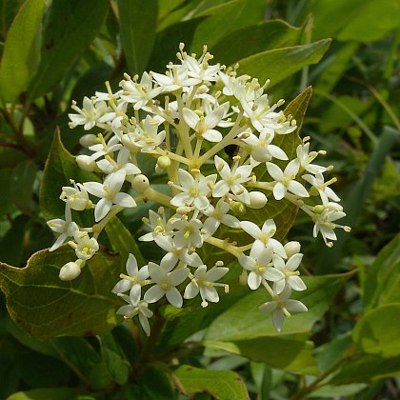Gray Dogwood Tree
Category: Deciduous Trees

Facts about Gray Dogwood Tree, "Scientific name for Gray Dogwood Tree is Cornus racemosa". Gray Dogwood Tree is native to United States especially the Northeastern parts. This Gray Dogwood Tree is thick especially if root suckers are not removed. Surprisingly, the growth rate is slow though it can reach 15 to 20 feet (4.57 to 6.09 meters) in maturity and spreading at same level.
It is tolerant to many climatic conditions. Gray dogwood requires part to full sun. The preferred soils should be moist and well drained. However, this tree can do well with all soil types whether dry or moist. It is also tolerant to air pollution.
The leaves are opposite, oval and taper pointed. The color is a mixture of purple red and green. It is not showy so it is hard to see it. When the leaves fall they are normally dusky purplish.
The bark of the Gray Dogwood Tree is normally reddish-brown but changes to gray as it ages. This is where the tree gets its name gray dogwood from.
The gray dogwood tree produces many stems and suckers. The older stems can reach up (5 meters) in height. The flowers bloom around June to July and are white, loosely clustered. The stems holding the flowers are red and provide a very contrasting look to the clusters of white berries which normally form after flowers drop.
When a person wants to grow the Gray Dogwood Tree as a shrub, pruning can be done. This should be done when the Gray Dogwood Tree is young. One can opt to leave a single stem or several stems.
The bright red fruits appear in September and October. The red color can be seen in gray dogwood after the fruits are gone and it persists to winter.
It is very perfect for gardens and as shrub borders, along streams or ponds and near buildings. Normally planted in groups and left alone to spread.
There are no serious pests that attack the gray dogwood tree. Dogwood bud gall may occur but it is not a significant problem. Bud Galls on the tree are abnormal vegetative growths that are a result of the feeding and egg laying of some mites and insects.
You can tell a Gray Dogwood trees age by the number of growth rings inside. Growth rings size shows what kind of conditions accrued that year, the temperature and if it was a dry or wet year.
Bark of the Gray Dogwood tree protects it from the elements and is made up of dead cells.
Gray Dogwood tree roots usually grow two to three times the width of the tree branches. The ideal time to fertilize your Gray Dogwood tree is in late fall or early spring. If you want to transplant a Gray Dogwood tree do it in fall, this is ideal for most trees.
Gray Dogwood tree growth is referred to as Meristem (The undifferentiated embryonic plant tissue from which new cells are created, as that at the tip of a root or stem). This tissue can be found at the tips of shoots and leaves. Inside the stem growth in thickness occurs at the vascular cambium.
Gray Dogwood trees make their own food from sunlight, carbon dioxide, water, and nutrients from the soil.

 Back To Category Deciduous Trees
Back To Category Deciduous Trees